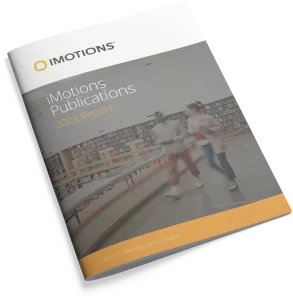-
Eye Tracking as a Method of Neuromarketing for Attention Research-An Empirical Analysis Using the Online Appointment Booking Platform from Mercedes-Benz
Abstract: A good user experience can only be achieved by knowing and understanding users’ wishes, needs and cognitive abilities. The aim of this study is to find out how the user of the online appointment booking interacts with the interface as well as the visualizations. The focus is on the question of whether the new […] -
Human-virtual character interaction: Toward understanding the influence of haptic feedback
Abstract: In this study, we compare haptic feedback and nonhaptic feedback conditions in which virtual characters bump into the participant who is immersed in a virtual environment. A questionnaire was developed to determine the influence of haptic feedback on a number of concepts (presence, embodiment, positive and negative affect, interaction realism with virtual character, and […] -
FaceSync: Open source framework for recording facial expressions with head-mounted cameras
Abstract: Advances in computer vision and machine learning algorithms have enabled researchers to extract facial expression data from face video recordings with greater ease and speed than standard manual coding methods, which has led to a dramatic increase in the pace of facial expression research. However, there are many limitations in recording facial expressions in laboratory […] -
Predicting Learners’ Performance Using EEG and Eye Tracking Features
Abstract: In this paper, we aim to predict students’ learning performance by combining two-modality sensing variables, namely eye tracking that monitors learners’ eye movements and electroencephalography (EEG) that measures learners’ cerebral activity. Our long-term goal is to use both data to provide appropriate adaptive assistance for students to enhance their learning experience and optimize their […] -
Basic Emotion Recogniton using Automatic Facial Expression Analysis Software
Abstract: Facial expression was proven to show a person’s emotions, including 6 basic human emotions, namely happy, sad, surprise, disgusted, angry, and fear. Currently, the recognition of basic emotions is applied using the automatic facial expression analysis software. In fact, not all emotions are performed with the same expressions. This study aims to analyze whether […] -
Mitigating passive fatigue during monotonous drives with thermal stimuli: Insights into the effect of different stimulation durations
Abstract: Driving on monotonous roads has been shown to cause passive fatigue as even non-sleep-deprived drivers suffer from the lack of stimuli. Consequently, alertness is reduced and the risk of accidents increases. To counteract this risk, measures need to be taken to mitigate driver fatigue. While in the past, some studies have been focused on […] -
Investigating the Relationship Between Mental State (Workload and Affect) and Physiology in a Control Room Setting (Ship Bridge Simulator)
Abstract: This paper discusses how to investigate the human element in a control room setting in terms of situational settings (monitoring and active control) and mental state (workload and affect). We show an explorative experiment in a ship bridge simulator context to investigate measurement practices and uncover correlations between mental state and changes in physiology. […] -
An Approach to Analyze User’s Emotion in HCI Experiments Using Psychophysiological Measures
Abstract: Emotional experiences have aroused HCI researchers’ interest once these types of experience involve many parts of our body, such as muscles, body postures, and psychophysiological measures. Hedonic experiences give us pleasure and good emotions, and this paper focuses on it. Some psychophysiological measures have already been correlated with both valence and arousal, the main […] -
Adding immersive virtual reality to a science lab simulation causes more presence but less learning
Abstract: Virtual reality (VR) is predicted to create a paradigm shift in education and training, but there is little empirical evidence of its educational value. The main objectives of this study were to determine the consequences of adding immersive VR to virtual learning simulations, and to investigate whether the principles of multimedia learning generalize to […] -
Improving Driver Emotions with Affective Strategies
Abstract: Drivers in negative emotional states, such as anger or sadness, are prone to perform bad at driving, decreasing overall road safety for all road users. Recent advances in affective computing, however, allow for the detection of such states and give us tools to tackle the connected problems within automotive user interfaces. We see potential […]
Research Report 2024
In-depth look at the scientific landscape as powered by iMotions software, showcasing groundbreaking research and the impact of our tools in various scientific and industrial fields.

iMotions Science Resources
Looking for white papers, validation reports or research show casing iMotions Multimodal capabilities?
Share Your Research

850+ universities worldwide with an iMotions human behavior lab
73 of the top 100 highest ranked universities
710+ published research papers using iMotions
iMotions is used for some of the most interesting human behavior research studies carried out by top researchers around the world. Contact us to have your publication featured here.
The authors of these publications have used iMotions as a software tool within their research.
“Software should be cited on the same basis as any other research product such as a paper or a book; that is, authors should cite the appropriate set of software products just as they cite the appropriate set of papers” (Katz et al., 2020).
We therefore encourage you to cite the use of iMotions where appropriate.
How to cite iMotions
APA
iMotions (10), iMotions A/S, Copenhagen, Denmark, (2024).
Note: adjust the version and year where relevant.
5 Most Popular Blogs
Publications
Read publications made possible with iMotions
Blog
Get inspired and learn more from our expert content writers
Newsletter
A monthly close up of latest product and research news


